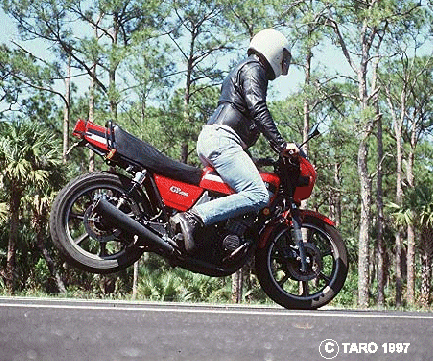
The Traffic Accident Reconstruction Origin -Approach Angles Solution-


The Traffic Accident Reconstruction Origin -Approach Angles Solution-
|

|

The rider of the bike (a GPZ550, if my eyes serve me correctly) is performing what is coloquially known as a "brakie," "stoppie," or "reverse wheelie." Using significant progressive front brake lever force slows the bike dramatically, shifting weight onto the front wheel, lightening the rear wheel. By sliding his body weight forward also, he has lightened the rear wheel enough that the typical 70-30 brake split generated by a good rider has been replaced with a 100-0 split. All the braking available is at the front wheel. The rear wheel can do nothing to stop the bike once in the air, and will now lock with almost no brake pressure. Less extreme cases simply lighten the rear wheel, making it easy to lock, which can cause untrained riders (or surprised riders) to lose control, especially while in turns.
The main lessons illustrated here are:
1. Front & rear brakes on motorcycles can have widely varying brake effectiveness depending on the operator's skill. Passenger cars have a preset a brake balance. The overall brake efficiency of a car dependent the driver's ability to modulate one pedal. A motorcycle rider must modulate a foot pedal and hand lever to get the best stopping performance.
2. Dynamic weight shift on a motorcycle during maneuvering and braking cannot be neglected when calculating braking percentages [a single long skid mark is almost certainly caused by a rear wheel, but the drag factor it generates can range from near zero to slightly less than the ratio of the static rear axle weight to total weight (both of which must be found with the rider involved in the accident)].
Since both the background trees and the image of the motorcycle are in focus and not blurred due to "panning the camera," and since the spokes on the wheels of the "bike" are also "still," my guess is that the "bike" was travelling at a very slow velocity at the time of the photo - my guess is just several miles-per-hour, perhaps even basically stopped as the shutter clicked on the camera. Also, due to the compression of the front forks, and the rear wheel in the air, all of the weight of the "bike" was concentrated on the front end at the instant the photo was taken.
All of this leads me to believe that the rider had applied the front brake at a very low rate of speed to the degree that it caused a very significant weight shift to the extent that the rear end of the "bike" lifted off of the ground. Again, at the time of the actual photo, the "bike" is basically not moving.
This is a little scary the first time you do it by accident, but can actually be kind of fun with a little practice - I used to do it all the time on my "dirt bike" when I was much younger!!
The biker is quite obviously performing what is known as a 'stoppie' It is evident that the front brake is applied heavily(from rider hand) and from the weight transfer compressing the front fork. It is quite possible for an experienced rider to performed a controlled lock of the front wheel, where the bike rotates around the contact point and the read end leaves the ground. There are two risks associated with this maneuver: Locking the front wheel and skidding drops the motorcycle, or it is alternately possible to go over the top and have the motorcycle follow. This is a fairly popular maneuver among many younger, dumber riders.
Since I used to ride motorcross and bicycle motorcross, years ago, I used to be able to do a front wheel stand very easily and with lots of control on a BMX bicycle, and on motorcycles (if they were light enough.)
It appears from the riders body position, [e.g. how his wrists are locked back to support his body from going over the handle bars, and the definition of his leg muscle noted through the jeans, that he was gripping the tank with his thighs, with everything he had, again to prevent himself from sliding too far forwards] that the rider intend to perform this manuver by traveling at a relatively slow speed, maybe 7 MPH, bracing himself in position and then locking the front brakes.
Because of the relatively short wheelbase, light weight, and a high center of gravity as compared against the wheelbase, of a motorcycle, it is not too hard to perform this trick. The hard part becomes not continuing too far over and/or falling off to one side.
This particular rider seems to be either quite skilled or quite lucky!
The only problem I could forsee for a Reconstructionist would be that there would probably be a very short skid mark, if any, and that would have come from the front wheel.
|
Copyright ©
|